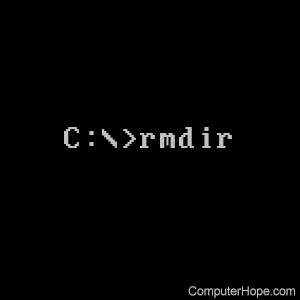Rd and rmdir commands

The rd and rmdir commands remove empty directories in MS-DOS. To delete directories with files or directories within them, you must use the deltree command. If you are running Microsoft Windows 2000 or Windows XP, use the /S option.
Availability
Rd and rmdir are internal commands that are available in the following Microsoft operating systems.
- All Versions of MS-DOS
- Windows 95
- Windows 98
- Windows Me
- Windows NT
- Windows 2000
- Windows XP
- Windows Vista
- Windows 7
- Windows 8
- Windows 10
- Windows 11
Rd and rmdir syntax
Windows XP and later syntax
RMDIR [/S] [/Q] [drive:]path RD [/S] [/Q] [drive:]path
| /S | Removes all directories and files in the specified directory in addition to the directory itself. It is used to remove a directory tree. |
| /Q | Quiet mode, do not ask if ok to remove a directory tree with /S. |
Windows 95, 98, and Me syntax
Removes (deletes) a directory.
RMDIR [drive:]path RD [drive:]path
Rd and rmdir examples
rmdir c:\full
If a directory contains files or folders, you will receive "The directory is not empty." error message if you try to use rd or rmdir. To delete directories that are full, use the deltree command or if you're using Windows 2000 or later, use the example code below with the /s switch.
rmdir c:\test
Remove the test directory, if it's empty.
rmdir c:\test /s
Windows 2000, Windows XP and later versions of Windows can use this option with a prompt to permanently delete the test directory, subdirectories, and files. Adding the /q switch would suppress the prompt.
